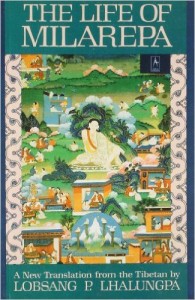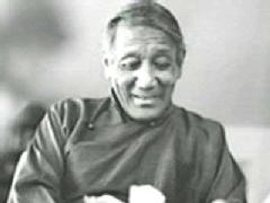Translated by Lobsang P. Lhalungpa
I am including this book review here (a review I wrote that was first published in “The San Francisco Review of Books,” June 1977) in honor of Lopsang Lhalungpa, who died from internal injuries in a car accident on April 28th, 2008, at the age of 82. For those of you who have not yet read his translation of this extraordinary autobiography, I heartily recommend that you do so. This is a book that I have returned to many times over the years.
The beauty and power of the autobiography of Milarepa, the beloved Tibetan saint of the 12th century, are splendidly manifest in this new English translation, the first to appear in more than 50 years. Though finding its sources in the magic and mystery of Tibet and in the precise psycho-spiritual teachings of Buddhism, particularly the Vajrayana, The Life of Milarepa cuts across all regional and doctrinal boundaries in its celebration of the search for “indestructible truth,” establishing itself as one of the great classics of world literature.
 In his luminous introduction to this new translation, Lobsang Lhalungpa, who has passed through the disciplines of the major branches of Tibetan Buddhism under many of its greatest living masters, points out that The Life of Milarepa is a “ritual drama” in which the events themselves carry “a profound knowledge of human psychology.” Every aspect of existence is included in this drama, from the most wretched to the most sublime. “We are actually witness to the creation of a spiritual world, an approach to the whole of life.”
In his luminous introduction to this new translation, Lobsang Lhalungpa, who has passed through the disciplines of the major branches of Tibetan Buddhism under many of its greatest living masters, points out that The Life of Milarepa is a “ritual drama” in which the events themselves carry “a profound knowledge of human psychology.” Every aspect of existence is included in this drama, from the most wretched to the most sublime. “We are actually witness to the creation of a spiritual world, an approach to the whole of life.”
The story opens with Milarepa’s birth, and the early death of his father. Left under the influence of a greedy and cruel aunt and uncle, Milarepa, his mother, and his sister are quickly reduced to poverty and suffering. His mother makes him vow to avenge this injustice and sends him off to learn black magic to destroy the relatives ‘down to the ninth generation.” Out of love for his mother, and through great effort and determination, Mila learns from the masters of sorcery how to cast spells and cause hailstorms, powers he uses to destroy the guests at the wedding feast of the Uncle’s eldest son and later to destroy the crops of the people of the village who are threatening his mother.
Milarepa now experiences overwhelming remorse and goes in search of a teacher who can show him the way to liberation. His meeting with Marpa the Translator, and the ordeals that Marpa puts him through to free him from delusion and from the consequences of his past acts, throw a powerful light on the process of real learning. As Lhalungpa writes: “In all of world literature there is no more dramatic portrayal of the kind of learning that a great Master provides for his pupil. No matter what else the reader may or may not take from this book, the account of ‘the ordeal of the towers’ will haunt him for the rest of his life.”
The last several chapters portray Milarepa’s initiation into the esoteric core of the teaching, his many years of meditation in order to experience in his own being the knowledge he has been given, his relationship with his disciples, and finally his miraculous disappearance into the “All-Encompassing Emptiness.” In these chapters it becomes clear that Milarepa’s transformation, though made possible by Marpa, is the outcome of his own persistent striving for compassion and for “perfect seeing.”
Simple and direct, yet evoking multiple levels of meaning, this translation of The Life of Milarepa will be welcomed by a broad spectrum of readers–from those who are interested in a gripping and poetic narrative to those who are looking for an accurate guidebook in the search for consciousness. It is one of those rare books that can penetrate to the heart, opening the reader to a sense of a deeper order in life.
Copyright 1977-2015 by Dennis Lewis

